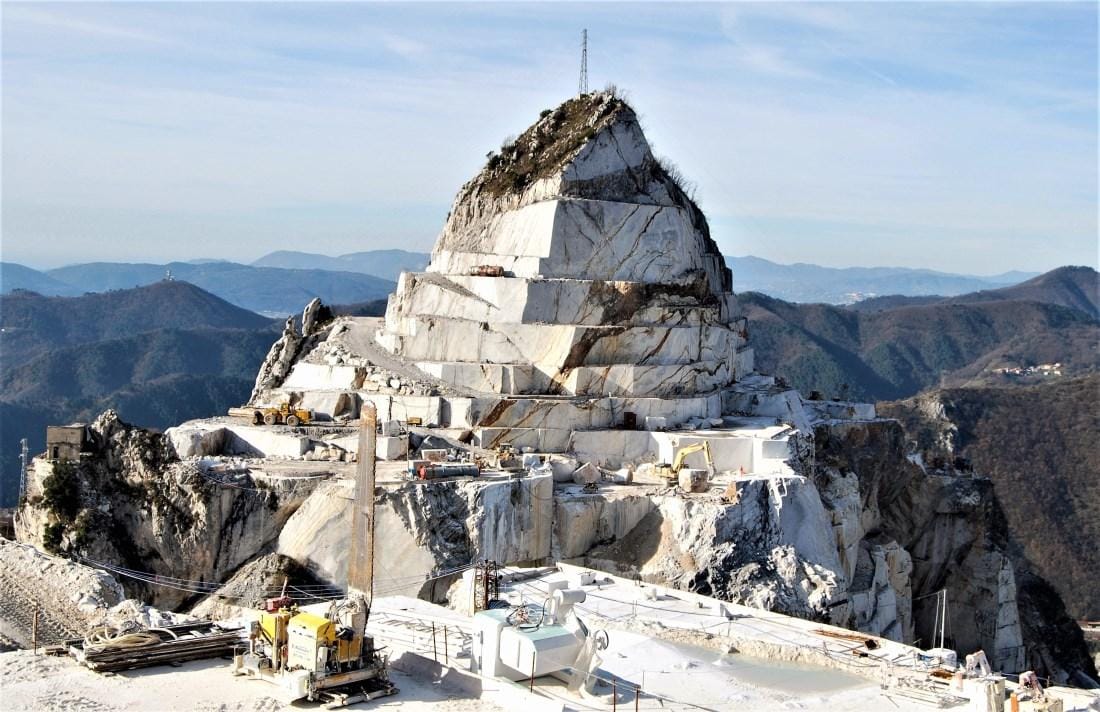The environmental cost of Italy’s fine white marble
Tommaso Gori in London

‘Mountains don’t grow back,’ reads the slogan of No Cav, the social environmental movement working to protect the Apuan Alps from marble extraction in the heart of Italy’s Tuscany region.
No Cav is a network of civil society organizations at the forefront of a battle to protect 160 active quarries from harmful pollution associated with Carrara marble extraction. Around 80 of the quarries are located within the boundaries of the UNESCO global geopark – a striking environmental paradox often referred to as a ‘mining park’.
Gianluca Briccolani, one of the movement’s leaders, describes a ‘wild west’ of extractivism in the valleys. ‘Here, calcium carbonate multinationals call the shots,’ he says.
Carrara marble extraction is mostly used to produce expensive marble blocks. But it is also partly composed of calcium carbonate – a valuable raw material used in construction, pharmaceuticals and cosmetics.
According to a report by Legambiente, Italy's leading environmental NGO, more than 68 million tonnes of material were extracted from these active quarries between 2005 and 2022. Of this, only 22 per cent consisted of marble blocks, while a staggering 77 per cent was made up of calcium carbonate.
Despite a 2020 court ruling that the land be managed collectively by local residents rather than the municipality or private entities – Henraux, a major marble company with global exports, has continued extracting marble from contested lands on Monte Altissimo.
The company has since secured authorization from the local government to extract 500,000 cubic meters over 10 years. Local and regional authorities have failed to adequately enforce environmental protections, allowing extensive quarrying to expand with fewer restrictions.
This has allowed marble slurry – marmettola, a fine dust resulting from marble cutting that forms a thick sludge when mixed with water – to flourish. The main source of environmental pollution in the Apuan Alps, it poses serious risks to soil and water quality. It seeps into water springs through fractures and crevices, compromising hydrological habitats. When deposited on riverbeds, it destroys micro-ecosystems and puts plant species at risk.
‘Marmettola has to be treated as waste,’ says Clara Masetti, an environmental scientist and project lead for Source International. ‘The rules [for waste management] exist, and we want them to be respected.’
Masetti says they are working on a report to be delivered to Italian authorities including the environment ministry, as well as UNESCO, outlining the dangers of this pollution.
No Cav and the NGO Source International completed a citizen science monitoring project on water pollution in the Apuan Alps last month. They equipped citizens with training and tools to monitor water pollution, including the presence of heavy metals like mercury and iron.
They also created an open source map displaying levels of pollution in water bodies on the alps. The map is publicly available and can be used as a tool to hold private companies to account for causing pollution.
No Cav also organised ‘The March of a Thousand’ protest in May to demand the end of destructive practices that harm the environment and local communities. The demonstration called for ending extractivism and shifting from a monocultural economy toward economic diversification, sustainable development, and the protection of the Apuan Alps’ natural and cultural heritage.
— Tommaso Gori (@tommasogori0098)
✍🏼 To understand the progressive methodologies adopted by the citizen science approach, visit Source International
👉 Check out the open source map on water pollution in the Apuan Alps
✅ Discover the history of the No Cav fight against marble extraction
📰 Read more about the environmental crisis surrounding the Apuan Alps from Al Jazeera
Read the latest issue of New Internationalist
Like what you've read? Support us with a tip
Looking for more? Listen to our podcast The World Unspun
Shop ethical goods at our very own Ethical Shop. Create an account and use the code CURR15 for 15% off your first order!

